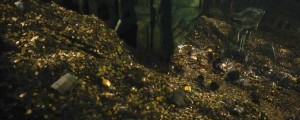 Just the other day, I was pondering the 12 silver pennies that Barliman Butterbur uses to buy Bill the Pony for Our Heroes in Bree. That, and the coins that he gives Merry as recompense for the ponies that fled Prancing Pony stables and eventually made their way back to Tom Bombadil.
Just the other day, I was pondering the 12 silver pennies that Barliman Butterbur uses to buy Bill the Pony for Our Heroes in Bree. That, and the coins that he gives Merry as recompense for the ponies that fled Prancing Pony stables and eventually made their way back to Tom Bombadil.
It’s interesting because this is one of the very few times a unit of currency is directly mentioned in the main text of The Lord of the Rings. In fact, the further we get from The Shire, the less money (and economics) becomes a factor within the story.
But how do economies work in Middle-earth? We know that, at least in the Third Age, trade of a sort occurs. Tobacco and other goods make their way to Isengard from The Shire. Bilbo purchases goods from Dale and Erebor for his farewell party. And the elves of Mirkwood do business with Lake-town and the mysterious region of Dorwinion.
In this piece, Michael Martinez draws on additional material from History of Middle-earth to fill in some of the blanks.
The merchants of Middle-earth
by Michael Martinez
Every now and then someone asks whether money was used in Middle-earth. It’s hard to find evidence of money in The Lord of the Rings but there are some references to it. When Gandalf arrived in Hobbiton with a wagon-load of fireworks for Bilbo and Frodo’s last birthday party together, Hobbit children followed him to Bag End hoping for some advance goodies. But instead Bilbo gave away a few pennies and sent the children on their ways. Gaffer Gamgee also notes that Bilbo is free with “his money” while talking with friends in a local inn..
Tolkien goes on to say in “Three Is Company” that Frodo purchases a house at Crickhollow between Brandy Hall and Newbury in the Buckland. Frodo later sells Bag End to the Sackville-Baggins family, the pestering cousins who for long had hoped to inherit Bilbo’s fortune and residence before Bilbo adopted Frodo.
Money comes up again when all the horses and ponies are stolen from Barliman Butterbur’s stable in Bree. He pays Merry 18 silver pennies to compensate him for the loss of the Hobbit’s ponies and purchases a pony from Bill Ferny for another 12 silver pennies, 3 times what the pony was worth. After this point, the Hobbits and the companions they gather are provided with supplies and transportation by the various peoples who help them, so money becomes a very transparent device for the rest of the story.
Pennies are an 8th century Anglo-Saxon coinage modelled on the contemporary but slightly older Frankish denier. Offa, King of Mercia, expanded penny production after he conquered the Kingdom of Kent, which had begun minting pennies around 765. The ancient pennies were thus unlike today’s pennies. They were made of silver and were the staple coin of the Anglo-Saxon realms from the 8th century onward, much as the solidus had been the staple coin of the Roman empire centuries before. Pennies replaced an older coin, called a sceat, which was used in commerce between the Anglo-Saxons and Scandinavians (the Anglo-Saxons’ close relatives).


